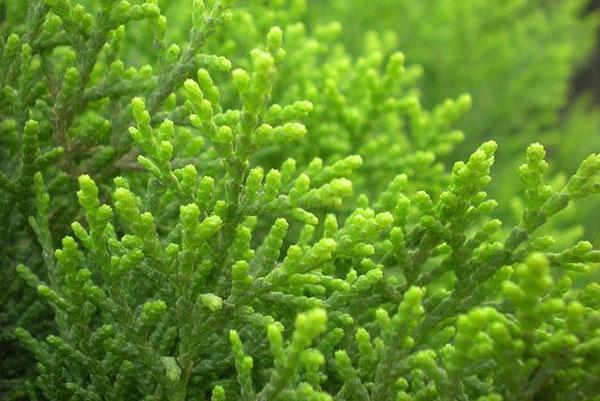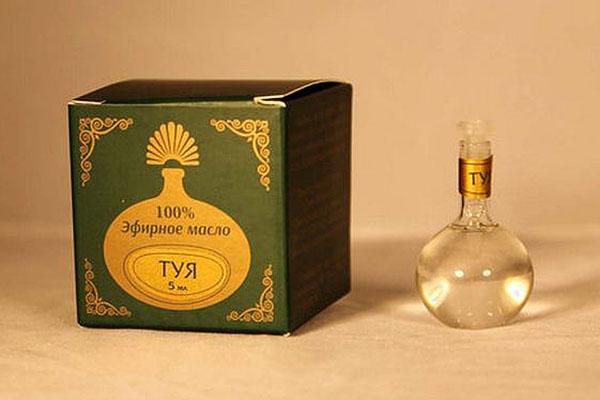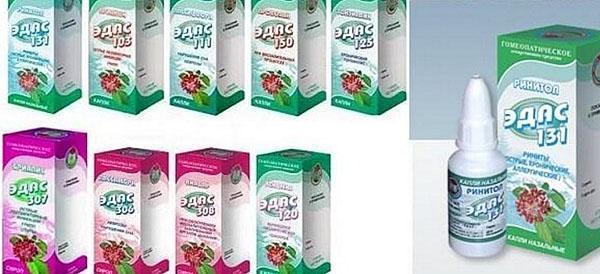The benefits of thuja oil and how to use it
 Thuja oil is obtained by steam distillation of young cones and needles of this tree. For the manufacture of 1 liter of oil, at least 250 kg of raw materials are required. The result is a clear oily liquid, sometimes with a slight yellow tint. It has a characteristic pungent aroma, just like the wood from which it is made. The healing properties of the oil were discovered in homeopathy in the 19th century, it was used to treat viral and inflammatory diseases, as well as bronchial asthma. Due to its pleasant smell and positive effect on the skin, it is used in cosmetology and perfumery.
Thuja oil is obtained by steam distillation of young cones and needles of this tree. For the manufacture of 1 liter of oil, at least 250 kg of raw materials are required. The result is a clear oily liquid, sometimes with a slight yellow tint. It has a characteristic pungent aroma, just like the wood from which it is made. The healing properties of the oil were discovered in homeopathy in the 19th century, it was used to treat viral and inflammatory diseases, as well as bronchial asthma. Due to its pleasant smell and positive effect on the skin, it is used in cosmetology and perfumery.
Composition and useful properties of oil

- Tannins have a local astringent, anti-inflammatory, hemostatic and bactericidal effect.
- Sesquiterpene alcohol inhibits the cough reflex at the level of the central nervous system, dilates the bronchi.
- Thujon is a neurotropic poison that can cause hallucinations, seizures and damage to parts of the brain in high concentrations, but is harmless in small amounts.
Thuja essential oil also contains resin and other substances. When applied locally, it relieves inflammation, fights against pathogenic microflora, eliminates pain, has a tonic effect and restores the body's own defenses. It also activates regeneration processes and heals wounds.
Indications for use
 The oil is used in traditional medicine both independently and as part of the complex treatment of a number of diseases. Before use, it is recommended to consult a doctor to make sure of the diagnosis, calculate the dosage and duration of treatment, as well as test for an allergic reaction. The remedy can be recommended:
The oil is used in traditional medicine both independently and as part of the complex treatment of a number of diseases. Before use, it is recommended to consult a doctor to make sure of the diagnosis, calculate the dosage and duration of treatment, as well as test for an allergic reaction. The remedy can be recommended:
- Thuja oil is indicated for viral respiratory diseases, which are manifested by an increase in body temperature, discharge of exudate from the nose, swelling and redness of the mucous membranes.
- It is used to treat adenoids in children, as well as in the postoperative period to prevent relapse.
- For asthma, bronchitis, pneumonia, the agent dilutes and removes phlegm.
- The oil stimulates regeneration and disinfects mucous membranes, therefore it is widely used in dentistry for the treatment of stomatitis, periodontal disease, bleeding gums.
- The remedy is effective in inflammatory diseases of the genitourinary system, including those of infectious origin.
- The oil has a general tonic effect, allows you to restore the immune defense after illness, stress and fatigue.
 The producers of thuja Edas oil also guarantee its effectiveness against papillomas and warts. This property of the drug has not been proven, but it can help with some cosmetic skin defects. It is able to relieve inflammation, swelling and fatigue, eliminate rashes, including those of nervous origin. The oil is also recommended to be applied to stretch marks.
The producers of thuja Edas oil also guarantee its effectiveness against papillomas and warts. This property of the drug has not been proven, but it can help with some cosmetic skin defects. It is able to relieve inflammation, swelling and fatigue, eliminate rashes, including those of nervous origin. The oil is also recommended to be applied to stretch marks.
Instructions for use
 The product is available in glass bottles with or without a dropper. Each box contains 1 bottle, as well as instructions for the use of thuja oil.
The product is available in glass bottles with or without a dropper. Each box contains 1 bottle, as well as instructions for the use of thuja oil.
The drug is used for medicinal purposes only as directed by a doctor.Based on the severity of the symptoms and the age of the patient, he will calculate the exact dosage and duration of the course of therapy.
Application methods:
- Thuja oil with sinusitis is instilled into the nose. It is allowed to drip 2 drops into each nostril no more than 3 times a day. The course of treatment lasts 14 days. If during this time it was not possible to eliminate the symptoms of the disease, the course is repeated after a 10-day break.
- Thuja oil for adenoids for children is used as part of inhalations. Add 3 drops of the remedy to 200 ml of hot water. The vapors should be inhaled for 20 minutes without covering your head with a towel.
- In viral respiratory diseases, which are manifested by a runny nose and an increase in body temperature, both instillation and inhalation are useful. The acceptable course of treatment is 14 days, but in most cases it is stopped earlier, with the complete elimination of symptoms.
For diseases of the upper respiratory tract and adenoids, it is useful to wear aromatherapy medallion with thuja oil. To do this, place 2 drops of oil in a small glass vessel, put it on the neck and do not remove it during the day. Vapors enter the nose when breathing and have a permanent healing effect.
In cosmetology, oil is applied pointwise or added to massage mixtures. It is recommended to combine thuja oil with olive or sea buckthorn oil to reduce its toxicity and aggressiveness. The resulting mixture is distributed in a small amount to problem areas and rubbed in with massage movements.
Thuja oil is not mixed with other esters and is not added to the composition of cosmetic or perfumery products.
Contraindications for use
 Despite all the positive properties of the product, not all patients can drip thuja oil into the nose or inhale its vapors. Among the contraindications for use are:
Despite all the positive properties of the product, not all patients can drip thuja oil into the nose or inhale its vapors. Among the contraindications for use are:
- individual sensitivity to individual components;
- the period of pregnancy (thujone can provoke abortion);
- pathology of the central nervous system (epilepsy).
If signs of an allergic reaction are observed during treatment with thuja oil, the course must be discontinued. In allergy sufferers, there is an intense discharge of exudate from the nose, lacrimation, redness of the visible mucous membranes. Swelling of the face may develop.
Thuja oil for runny nose, sinusitis, adenoids, infectious and inflammatory processes in the body is an effective remedy. Before use, you should definitely consult a doctor, make an accurate diagnosis, determine the degree of the disease and make sure that there are no contraindications.